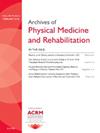Effect of Telerehabilitation-Based Motor Imagery Training on Pain and Related Factors in People With Multiple Sclerosis: Randomized Controlled Pilot Trial
IF 3.6
2区 医学
Q1 REHABILITATION
Archives of physical medicine and rehabilitation
Pub Date : 2025-04-01
DOI:10.1016/j.apmr.2024.10.009
引用次数: 0
Abstract
Objectives
To investigate the effect of telerehabilitation-based graded motor imagery (MI, GMI) training on pain and pain-related factors in people with multiple sclerosis (MS).
Design
Randomized controlled, assessor-blind pilot trial with repeated-measure design.
Setting
Neurology outpatient clinic.
Participants
Thirty-two people with MS were randomly allocated to intervention (n=16) and control (n=16) groups.
Interventions
During the 8-week GMI training period, the first 2 weeks involved implicit MI training while 6 weeks of explicit MI training were conducted.
Main Outcome Measures
The primary outcome was the general pain intensity over the past 2 days, assessed with a visual analog scale, with a minimum clinically important difference (MCID) of 23 mm. Secondary outcomes included general pain and specific body parts’ pain intensity over the past 7 days, neuropathic pain intensity, MI ability, fatigue, depression, anxiety, quality of life, sleep quality, daytime sleepiness, and cognitive functions scores. Assessments were conducted at baseline, at weeks 8 (post-treatment) and 12 (follow-up).
Results
The intervention group demonstrated a significant reduction in pain intensity over the past 2 days compared with control group (P<.05). Furthermore, at the 8-week assessment, the intervention group surpassed the MCID in pain intensity over the past 2 and 7 days (P<.05), whereas no significant change was observed in the control group (P>.05). Significant effects were observed post-treatment on general pain over the past 7 days, neuropathic pain, MI ability, fatigue, depression, quality of life, processing speed, and visuospatial memory within intervention group compared with control group (P<.05). However, the effect on anxiety, sleep quality, daytime sleepiness, and verbal memory between groups was not significant (P>.05).
Conclusions
Telerehabilitation-based GMI training stands out as viable for the management of chronic pain and pain-related psychosocial symptoms for people with MS.
基于远程康复的运动想象训练对多发性硬化症患者疼痛及相关因素的影响:随机对照试验。
目的:研究基于远程康复的分级运动想象(MI,GMI)训练对多发性硬化症患者疼痛及疼痛相关因素的影响:研究基于远程康复的分级运动想象(MI,GMI)训练对多发性硬化症(MS)患者疼痛及疼痛相关因素的影响:随机对照、评估者盲法试验,重复测量设计:参与者:32 名多发性硬化症患者:32 名多发性硬化症患者被随机分配到干预组(16 人)和对照组(16 人):在为期8周的GMI训练期间,前2周进行隐性MI训练,6周进行显性MI训练:主要结果:主要结果是过去两天的一般疼痛强度,采用视觉模拟量表进行评估,最小临床重要差异(MCID)为 23 毫米。次要结果包括过去七天的一般疼痛和特定身体部位疼痛强度、神经病理性疼痛强度、心肌缺血能力、疲劳、抑郁、焦虑、生活质量、睡眠质量、白天嗜睡和认知功能评分。评估在基线、第 8 周(治疗后)和第 12 周(随访)进行:结果:与对照组相比,干预组过去两天的疼痛强度明显降低(P0.05)。与对照组相比,干预组在治疗后对过去七天的一般疼痛、神经性疼痛、心肌缺血能力、疲劳、抑郁、生活质量、处理速度和视觉空间记忆等方面均有显著效果(P0.05):结论:基于远程康复的 GMI 培训在治疗多发性硬化症患者的慢性疼痛和与疼痛相关的社会心理症状方面具有显著的可行性。
本文章由计算机程序翻译,如有差异,请以英文原文为准。
求助全文
约1分钟内获得全文
求助全文
来源期刊
CiteScore
6.20
自引率
4.70%
发文量
495
审稿时长
38 days
期刊介绍:
The Archives of Physical Medicine and Rehabilitation publishes original, peer-reviewed research and clinical reports on important trends and developments in physical medicine and rehabilitation and related fields. This international journal brings researchers and clinicians authoritative information on the therapeutic utilization of physical, behavioral and pharmaceutical agents in providing comprehensive care for individuals with chronic illness and disabilities.
Archives began publication in 1920, publishes monthly, and is the official journal of the American Congress of Rehabilitation Medicine. Its papers are cited more often than any other rehabilitation journal.

 求助内容:
求助内容: 应助结果提醒方式:
应助结果提醒方式:


